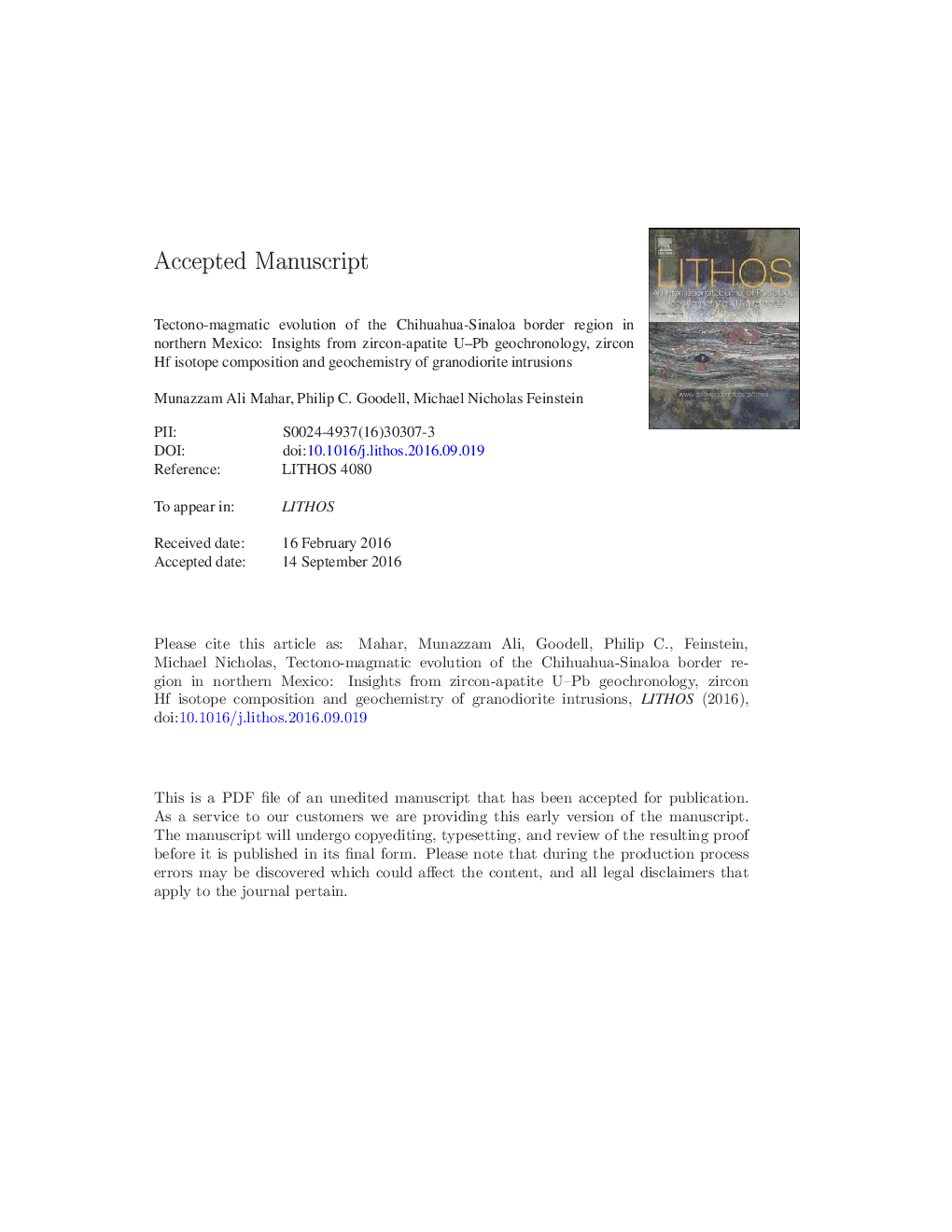| کد مقاله | کد نشریه | سال انتشار | مقاله انگلیسی | نسخه تمام متن |
|---|---|---|---|---|
| 6440298 | 1638640 | 2016 | 79 صفحه PDF | دانلود رایگان |
عنوان انگلیسی مقاله ISI
Tectono-magmatic evolution of the Chihuahua-Sinaloa border region in northern Mexico: Insights from zircon-apatite U-Pb geochronology, zircon Hf isotope composition and geochemistry of granodiorite intrusions
دانلود مقاله + سفارش ترجمه
دانلود مقاله ISI انگلیسی
رایگان برای ایرانیان
کلمات کلیدی
موضوعات مرتبط
مهندسی و علوم پایه
علوم زمین و سیارات
ژئوشیمی و پترولوژی
پیش نمایش صفحه اول مقاله

چکیده انگلیسی
We present the whole-rock geochemistry, LA-ICP-MS zircon-apatite U-Pb ages and zircon Hf isotope composition of the granodioritic plutons at the southwestern boundary of Chihuahua with the states of Sinaloa and Sonora. These granodiorites are exposed in the north and south of the Rio El Fuerte in southwest Chihuahua and northern Sinaloa. The magmatism spans over a time period of 37 Ma from 90 to 53 Ma. Zircons are exclusively magmatic with strong oscillatory zoning. No inheritance of any age has been observed. Our new U-Pb dating (~ 250 analyses) does not support the involvement of older basement lithologies in the generation of the granitic magmas. The U-Pb apatite ages from granodiorites in southwest Chihuahua vary from 52 to 70 Ma. These apatite ages are 1 to 20 Ma younger than the corresponding zircon U-Pb crystallization ages, suggesting variable cooling rates from very fast to 15 °C/Ma (~ 800 °C to 500 °C) and shallow to moderate emplacement depths. In contrast, U-Pb apatite ages from the Sinaloa batholith are restricted from 64 to 61 Ma and are indistinguishable from the zircon U-Pb ages range from 67 to 60 Ma within the error, indicating rapid cooling and very shallow emplacement. However, one sample from El Realito showed a larger difference of ~ 20 Ma in zircon-apatite age pair: zircon 80 ± 0.8 Ma and apatite 60.6 ± 4 Ma, suggesting a slower cooling rate of ~ 15 °C/Ma. The weighted mean initial εHf (t) isotope composition (2Ï) of granodiorites varies from + 1.8 to + 5.2. The radiogenic Hf isotope composition coupled with previous Sr-Nd isotope data demonstrates a significant shift from multiple crustal sources in the Sonoran batholithic belt to the predominant contribution of the mantle-derived magmas in the southwest Chihuahua and northern Sinaloa. Based on U-Pb ages, the absence of inheritance, typical high Th/U ratio and radiogenic Hf isotope composition, we suggest that the Late Cretaceous-Paleogene magmatic rocks in this region are not derived from melting of a felsic older crust, neither evolved North American Proterozoic basement nor Jurassic metasedimentary rocks of the Guerrero terrane. Instead, the magma was primarily derived from partial melting of mantle related sources, possibly in the subcontinental mantle wedge above the Farallon plate. Our younger U-Pb zircon-apatite ages are well correlated with the late-stage cogenetic porphyry Cu-Au mineralization at 57 to 59 Ma. If the origin of ore mineralization is related to the magma sources of host batholiths, then a minimal input from crustal melt is suggested in the genesis of Cu-Au porphyry system.
ناشر
Database: Elsevier - ScienceDirect (ساینس دایرکت)
Journal: Lithos - Volume 264, 1 November 2016, Pages 555-576
Journal: Lithos - Volume 264, 1 November 2016, Pages 555-576
نویسندگان
Munazzam Ali Mahar, Philip C. Goodell, Michael Nicholas Feinstein,